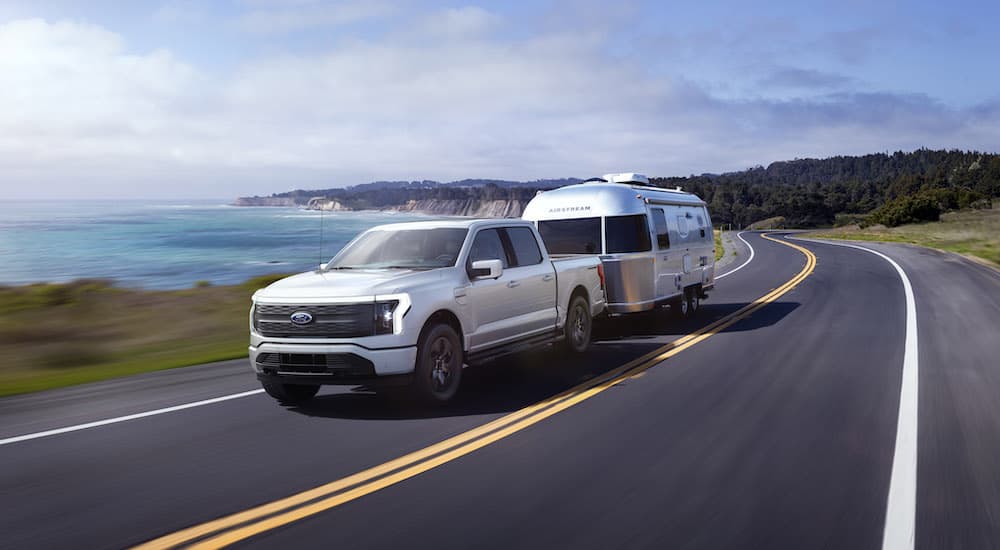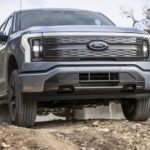It’s happened. We’re at a crossroads in the development of electric vehicles; we’re beginning to see more electric vehicles (EVs) in places you’d least expect. For example, there’s soon to be an electric F-150. This wasn’t too much of a surprise since other manufacturers had made it abundantly clear this was one of the more successful-looking avenues to pursue—especially Chevy, with the release of their rival Silverado EV.
However, choosing your next F-150 isn’t as simple as picking between the gasoline-powered one and the new electric one, and that’s because of a price disparity. That’s right: despite the similar namesake, these two trucks are worlds apart—but that can’t be the whole story, can it? Well, there is, and we’re here to give you enough insight to take to a Ford dealer and dominate your next shopping experience.
We’re Gonna Rock Down to Electric Avenue
With the F-150 Lightning, your powerplant comes down to a choice between two batteries. This is in stark contrast to the five available powertrains for the regular F-150, but in regards to horsepower and torque output, both F-150 Lightning powertrains can run circles around any of those five F-150 gas engines.
Starting with the base powertrain, the F-150 Lightning comes equipped with a 98-kWh battery that pairs with two electric motors and a Continuously Variable Automatic Transmission (CVT). Performance benchmarks find the 98-kWh battery and its motors outputting 452 hp and 775 lb-ft of torque; this exceeds the most performant F-150 models—those equipped with the turbocharged hybrid powertrain. In their peak configuration, these hybrid F-150s output 430 hp and 570 lb-ft of torque.
Although the aforementioned price difference doesn’t make this next comparison fair, it’s still a fun difference to mention: the base F-150 Lightning with the 98-kWh battery creates 56% more horsepower and 192% more torque than the traditional base F-150 and its 3.3L V6 gas engine that outputs 290 hp and 265 lb-ft of torque.

There must be a catch, right? Somewhat. When driving an F-150 Lightning, you can haul an incredible amount of cargo for an electric vehicle—it truly is spectacular. However, it doesn’t always manage to outperform the gasoline-powered F-150 in towing performance.
Of course, this all depends on which variant you have of which truck, but the gasoline-powered F-150 commonly harnesses a higher towing rating. The F-150 Lightning and its base 98-kWh battery can tow a maximum of 7,700 lbs; that’s impressive considering it’s not only running exclusively off electricity, but it’s only a measly 500 lbs less than the base gasoline-powered F-150. What the F-150 Lightning’s base powertrain has over the 3.3L V6 engine is its payload capacity, which sits at a maximum of 2,235 lbs over 1,955 lbs from the regular F-150.
If a towing capacity of 7,700 lbs isn’t enough for you, then don’t worry because the F-150 Lightning has you covered. If you don’t want the 98-kWh battery-equipped powertrain, there’s a stronger powertrain that not only tows more than the base one but can travel longer distances on a full charge, too.
The benefit of a bigger battery—like the ones you’d find in the F-150 Lightning—is excellent performance and larger charges, but you can get an even BIGGER battery with a powertrain upgrade. This tremendously increases your powerplant from a 98-kWh battery to a 131-kWh battery, which is nearly 34% larger. Regardless of the battery’s size, the truck’s frame doesn’t change, especially since there’s a sole bed size: a five-foot, six-inch bed with 52.8 cu.ft. of space. However, there’s a frunk, too—which gasoline-powered cars like the regular F-150 don’t have—that has an additional 14.1 cu.ft. of space.
The greater size of this battery calls for a hike in both horsepower and towing; torque remains the same, and the payload capacity is slightly lessened to 1,952 lbs. With the 131-kWh battery, you get 580 hp and 775 lb-ft of torque, and the towing capacity is increased to a solid 10,000 lbs. This towing capacity is more similar to the turbocharged 2.7L V6 gas engine in the regular F-150, which is 10,100 lbs—only 1% more, so it’s an impressive showing for the F-150 Lightning.
You’re Gonna Go Places
Can you imagine if Ford did all this work to create an electric pickup truck, but the thing can’t even travel across town without running out of charge? Fortunately, that’s not the case with the F-150 Lightning—you can eat your cake and have it too. Performance and efficiency are two peas in a pod with the Lightning, as I hinted earlier, especially if you’re buying the F-150 Lightning with the larger 131-kWh battery. This probably has you wondering how far you’ll go on a single charge, and you may also be wondering what your options for charging your truck are…
First, the F-150 Lightning’s two powertrains are the ‘Standard Range’ and ‘Extended Range;’ the 131-kWh battery is the latter, while the base 98-kWh battery is the former. Both powertrains have all-wheel drive, which is important when shopping for something versatile like a pickup truck. The Extended Range powertrain expectedly allows for longer distances between recharges, but the Standard Range is still good enough to have a range of 240 miles on a fully charged battery.

With the larger battery—and its extended range—you can travel 320 miles on a full charge. The Standard Range battery is an excellent showing for a pickup truck, but the Extended Range’s 131-kWh battery gives you the performance the F-150 is so well known for while being far more generous in how far you can travel without stopping.
What do you do when you need to charge, and how long will it take to charge the battery? Well, recharging your F-150 Lightning can be done at home as well as on the go. If you’re at home and your truck isn’t in use, you can plug it into a wall unit like the Ford Charge Station Pro, which comes with the purchase of a Ford F-150 Lightning with Extended Range; this will fully charge your battery in around eight hours. So you can recharge your truck while you’re asleep at night and have a full battery ready to go for your drive to work, while everyone else on the road has to make an early stop at the gas station.
When you’re not home, you can use a Mobile Power Cord from Ford that utilizes a 240-volt connector, so you can plug it in wherever you can find an outlet; this will charge the Extended Range battery in 20 hours. Otherwise, with the infrastructural Blue Oval Network, you can access around 84,000 public charging stations that won’t give you any hassle when you’re getting a charge; it intelligently knows you’re an owner of the Ford F-150 Lightning and, therefore, part of the Blue Oval Network. These chargers are insanely fast, adding around 54 miles to your available range in nearly ten minutes. This is the best possible amenity for an electric vehicle owner, and Ford has got you covered.
The Truck of the Future
It’s no surprise—nor is it news—that the F-150 is the best-selling vehicle in America. However, does the F-150 Lightning have what it takes to become the best-selling ELECTRIC vehicle? I believe so, but this section of the market is so embryonic that it’s anyone’s guess as to how this will all turn out. I can confidently say, however, that Ford knows what they’re doing, and it’s always wise to keep them on your radar.



